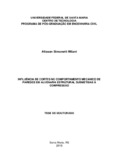| dc.creator | Milani, Alisson Simonetti | |
| dc.date.accessioned | 2019-12-23T11:43:46Z | |
| dc.date.available | 2019-12-23T11:43:46Z | |
| dc.date.issued | 2019-09-13 | |
| dc.identifier.uri | http://repositorio.ufsm.br/handle/1/19213 | |
| dc.description.abstract | Chases in masonry walls with no design prediction are often found in Brazilian buildings, usually for electrical, hydraulic, gas, air-conditioning, and other installations. As the wall is the supporting element in this constructive system, a chase can cause significant changes in its mechanical behavior. Both Brazilian and international standards only present limitations for these changes in geometry, but do not provide information about the effect on mechanical behavior when these limits are exceeded. This study pursued the verification of different chase geometries on the structural masonry walls mechanical behavior when submitted to axial loading, through experimental analyzes in small-scale models (1:5). Horizontal, vertical and diagonal Chases with 20%, 30% and 50% depths were considered. Effects of eccentric loading were also analyzed. The increase in chase depth resulted not only in resistance reduction, but also changed the stress-strain behavior, with large deformations and out off plane displacements occurring near failure due to the flexing effects caused by eccentricity generated by the chases. Strains on the moment of rupture were smaller for walls with chases. These effects were amplified for of walls with eccentric loads. The deformation modulus presented significant changes only for walls with 50% chases. The typology that presented the greatest resistance loss was the horizontal chase at half height, followed by the top horizontal and finally diagonal chase. Masonry walls with vertical chases do not show differences in the mechanical behavior in relation to the reference walls. Finally, correlations between chase depth and net area reduction with resistance loss were developed, being this last analysis a linear relationship. | eng |
| dc.language | por | por |
| dc.publisher | Universidade Federal de Santa Maria | por |
| dc.rights | Attribution-NonCommercial-NoDerivatives 4.0 International | * |
| dc.rights.uri | http://creativecommons.org/licenses/by-nc-nd/4.0/ | * |
| dc.subject | Alvenaria estrutural | por |
| dc.subject | Corte em paredes | por |
| dc.subject | Escala reduzida | por |
| dc.subject | Structural masonry | eng |
| dc.subject | Wall chases | eng |
| dc.subject | Small scale | eng |
| dc.title | Influência de cortes no comportamento mecânico de paredes em alvenaria estrutural submetidas à compressão | por |
| dc.title.alternative | Influence of chases in mechanical behavior of structural masonry walls under compression | eng |
| dc.type | Tese | por |
| dc.description.resumo | Cortes em paredes de alvenaria estrutural, sem previsão em projeto, são encontrados frequentemente nas obras brasileiras, em geral para passagens de instalações elétricas, hidráulicas, gás, condicionadores de ar, entre outras. Uma vez que nesse sistema construtivo a parede é o elemento de suporte, um corte, pode causar alterações significativas no comportamento mecânico da parede. Tanto as normas brasileiras como as internacionais apenas apresentam limitações para a geometria dos cortes, porém não trazem informações sobre as alterações no comportamento mecânico das paredes quando esses limites são ultrapassados. Esse estudo buscou verificar a influência da execução de cortes no comportamento mecânico de paredes de alvenaria estrutural submetidas à carregamento axial, realizando-se análises experimentais em modelos em escala reduzida (1:5). Foram estudados cortes, horizontais, verticais e inclinados, com profundidades de 20%, 30% e 50%. Ainda foram verificados os efeitos do carregamento excêntrico. O aumento da profundidade dos cortes, além de redução da resistência, resultaram em alterações no comportamento tensão versus deformação, ocorrendo, próximo à ruptura grandes deformações e deslocamentos fora do plano, resultado dos efeitos de flexão devido à excentricidade gerada pelos cortes. As deformações específicas na ruptura reduziram nas paredes com cortes. Esses efeitos foram amplificados no caso das paredes com carregamentos excêntricos. O módulo de deformação apresentou diferenças significativas apenas nas paredes com cortes a partir de 50%. A tipologia que apresentou a maior perda de resistência foi a de corte horizontal a meia altura, seguida da horizontal superior, e por último corte inclinado. As paredes com cortes verticais não apresentaram diferenças no comportamento mecânico em relação às paredes de referência. Por fim foram estabelecidas relações entre a profundidade dos cortes e redução da área líquida com as perdas de resistência, sendo essa última uma relação linear. | por |
| dc.contributor.advisor1 | Mohamad, Gihad | |
| dc.contributor.advisor1Lattes | http://lattes.cnpq.br/5446970753192990 | por |
| dc.contributor.advisor-co1 | Santos Neto, Almir Barros da Silva | |
| dc.contributor.advisor-co1Lattes | Sem currículo lattes. | por |
| dc.contributor.referee1 | Correa, Marcio Roberto Silva | |
| dc.contributor.referee1Lattes | http://lattes.cnpq.br/7780769246876333 | por |
| dc.contributor.referee2 | Sánchez Filho, Emil de Souza | |
| dc.contributor.referee2Lattes | http://lattes.cnpq.br/7266906180520143 | por |
| dc.contributor.referee3 | Kripka, Moacir | |
| dc.contributor.referee3Lattes | http://lattes.cnpq.br/7554233520986997 | por |
| dc.contributor.referee4 | Lübeck, André | |
| dc.contributor.referee4Lattes | http://lattes.cnpq.br/7511022637484145 | por |
| dc.creator.Lattes | http://lattes.cnpq.br/6091255468174471 | por |
| dc.publisher.country | Brasil | por |
| dc.publisher.department | Engenharia Civil | por |
| dc.publisher.initials | UFSM | por |
| dc.publisher.program | Programa de Pós-Graduação em Engenharia Civil | por |
| dc.subject.cnpq | CNPQ::ENGENHARIAS::ENGENHARIA CIVIL | por |
| dc.publisher.unidade | Centro de Tecnologia | por |



